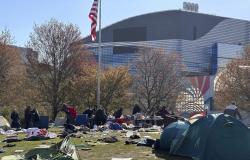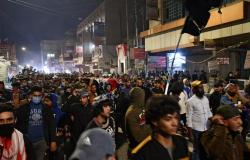Hanna, 43, was a preschool teacher in Ukraine when her life was directly impacted by Russia’s invasion of her country on February 24, 2022. After moving cities repeatedly, each time occupied by Russian forces, she gathered her family and announced: she was determined to become a fighter.
“My decision was a little unexpected for my family because I had been thinking about it alone for some time. At first I hesitated, but when I made the decision, I told them. They were a little shocked, but they understood that it was my decision and that I I needed to do that,” says Hanna.
For security reasons, the people interviewed for this report only provided their first names.
She informed the Ukrainian Army that she would like to fight and was recruited earlier this year. She joined 80 other compatriots with no military experience at all and went for five-week military training in the United Kingdom.
The teacher says that physically she is not yet ready to become a sniper — this will be her role on the front lines of combat, despite never having picked up a weapon before 2023.
“Morally and emotionally, I’m prepared. Not physically yet, but I’m training and dedicating myself to getting ready as quickly as possible,” she says.
In the first week of March, Hanna picked up a semiautomatic rifle for the first time. The beginning of spring is still very cold, and the winds cut the teacher’s hands. It is difficult to adjust the aim in these conditions — in Ukraine, despite the low temperatures, the wind is not as strong as in the north of England, where the training takes place.
“At first it was a little scary, but then I got used to it, and now the gun is my friend,” says Hanna.
Out there
Receive in your email a weekly selection of the most important things happening in the world
The military training that she and almost a thousand other Ukrainians are currently receiving is the result of cooperation between the United Kingdom Armed Forces and 12 other countries. The focus of the so-called Operation Interflex is to train Ukrainians with no military experience who are willing to fight in the war against Russia.
They are teachers, university students, restaurant managers and professionals from other areas, ages ranging from 18 to 50 years old. Since the start of the Russian invasion, around 36,000 civilians have come to the United Kingdom to undergo training.
A Sheet he was in the military camp that the British prepared in the north of England to train new soldiers. It is a large piece of land separated into two spaces: one for urban warfare, with scattered houses and apartments that simulate a city invaded by enemies; and another for rural conflict, in open fields with uneven terrain.
The space underwent a series of adaptations to the Ukrainian reality — trenches more than one meter deep were dug, and old houses in the region were emptied.
“We only have five weeks to try to convey as much information as possible. Our focus is very much on [treinos] with small arms and rifles, to ensure that they are in the best possible shape when returning to Ukraine”, reports British Captain McNally, one of those responsible for Operation Interflex training.
One of the instructors, Lieutenant Christian, a Norwegian, says that the Ukrainian War brought a series of changes in relation to previous conflicts. Offensive drones are one of the hallmarks of the Russians, for example, who use them in addition to traditional infantry tactics.
“But the skill set is pretty much the same. So for this basic infantry course, we talk a lot about rescue tactics and we use old NATO concepts. Because at the basic level, the skills for the infantry are the same as 20 years ago.”
To develop infantry skills in civilians, training is focused on real conflict situations — fighting in trenches, occupying houses and buildings, first aid and classes on international laws on war.
“The main challenge we face here is that we don’t have enough time to rest or recover. This basic infantry course is supposed to last three months, but here we don’t have time for that. We’re doing this course in five weeks, and the longer we spend here, the more our country needs us to enter the front line”, says Dmitro, 31, one of the Ukrainians taking tests to become an instructor.
He worked in private security before the war. He will return to Ukraine in two weeks, as a soldier, and will work both on the front line and training new recruits.
Galina, 19, says that she became interested in weapons as a child, at 9, when Russia invaded Crimea in 2014 — a moment that, for Ukrainians, represented the true beginning of the war.
She had dreams of being an engineer and was working in a shopping mall when the current invasion began. For her, life in her country has become extremely stressful because war occurs “every day”, and in all of them “there are deaths”.
Galina’s brother was on the front line with the other Ukrainians in the resistance against the Russian offensive. He ended up hit by shrapnel in the head and is in a coma.
“In these first three weeks they gave us, in general terms, all the skills we must have to go to war. I joined the Army to protect my country; so that it continues to be my country”, says Galina.
Since the escalation, there has been a large migratory flow of Ukrainian refugees to European countries. The UN estimates that around 10 million people have been forced to abandon their homes, with just under 4 million internally displaced.
In the first half of 2022, more than 100 thousand Ukrainians came to the United Kingdom. From there, many ended up moving to other regions of the world. The Ukrainian embassy in London did not disclose the approximate number of refugees remaining on British soil.
Bishop Kenneth Nowakowski, responsible for the Ukrainian Catholic Cathedral in London, says that this is the third wave of migration of Ukrainians in recent decades.
The first, after the Second World War, brought around 30,000 Ukrainians to the United Kingdom. The number more than doubled in 1991, after the collapse of the Soviet Union.
“Before Russia’s full-scale invasion of Ukraine in 2022, we had around 2,500 to 2,600 people regularly attending Sunday services. I would say that since the invasion, the average number of people attending is over 3,000.” , says Nowakowski.






